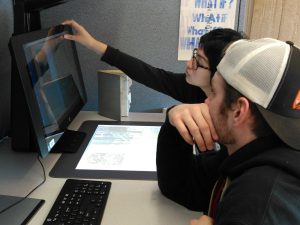This week, we ran into several tech challenges with Visiting Assistant Professor of Literature Andrew Rippeon’s “Unpacking My Library” course.
Following our prior attempt to produce 3D scans of “altered book” art objects, the students decided that the noise and random digital alteration from the imperfect 3D scans worked to augment their project. We continued 3D scanning, leaning in to the Sprout as a creative process. Some of the scans can be viewed on Remix3D.
Previously, we had thought Aurasma might be the perfect solution for our AR needs. However, while Aurasma does support 3D models, it requires a specific file type; the best practices involve designing scenes in Maya, and so it does not work quickly with 3D scans. Given the scope of this course, we have opted to not use Aurasma’s 3D model support. Instead, we plan to store our 3D models in a repository online, and make use of Aurasma’s capacity to link to websites, triggering a visit to the 3D model repository when the Aura is tapped.
Uploading the 3D scans proved another challenge. The students had saved them as .3mf files, the default for the Sprout Pro. These files do not upload to Sketchfab, which is the site we’ve generally used for showing our 3D models. You can think of it as a YouTube or Flickr for 3D designs and scans!
We had some trouble finding an app that would work to convert these into a 3D file type that Sketchfab recognized. We eventually used Paint 3D to convert the files, but the textures did not come across; given time constraints, rather that trying to extract textures, we used Paint 3D’s able to upload the files it can open to Remix3D, another 3D model site. Unfortunately, Remix3D has a file size limit, so scans which captured a lot of texture could not be uploaded. Remix3D also has community standards that removed several of the altered books, including one which had featured the word “abortion,” making it not ideal for an educational environment that may produce projects about controversial topics.
The Sprout also scans in .obj files, which we work with more routinely in our 3D scanning, model creation, and 3D printing; we plan to conduct future Sprout scans as .obj files.


